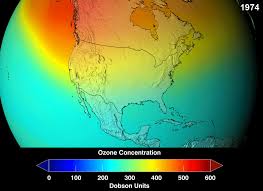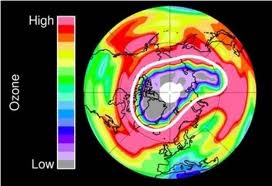
Ozone Layer Facts



A few ozone layer facts could help people to realize what it does for us and why we need so desperately for it to stay intact.
Despite attempts to reduce the effects of chemicals and pollution on the ozone layer, we continue to harm it.
Here are some ozone layer facts that not everyone might know.
• In its thickest places, the ozone layer is only about 30 miles thick. It sits about 10 to 20 miles about the Earth’s surface, in the stratosphere.
• Ozone exists in small amounts throughout our atmosphere and even near the surface of the earth. However, 90% of it is in the ozone layer.
• The ozone layer filters out most of our sun’s ultraviolet radiation, keeping it from penetrating all the way through to us. Consider your worst sunburn and imagine how bad it would be for there to be no ozone to filter the rest of it out!
• Chlorofluorocarbons – CFCs – break down in the stratosphere and release chlorine. Chlorine atoms attack ozone, breaking it apart and depleting the ozone. Each chlorine atom can destroy up to 100,000 ozone molecules. This is why we are warned to avoid using items containing CFCs.
• The thinning of the ozone layer – what we now know as ‘the hole in the ozone layer’ was discovered by scientists in the Antarctic in 1985.
• There are only approximately three ozone molecules for every 10 million molecules of oxygen, yet it plays an extremely important role in our atmosphere.
• The ozone layer helps to regulate the temperature of the earth’s atmosphere, keeping us from either overheating or freezing. When healthy, the ozone layer keeps out UV radiation and retains enough warmth to keep the earth’s flora and fauna alive.
• When down on the earth’s surface, ozone is destructive to plants, animals, and human health because it has strong reactions to other molecules.
• Levels of ozone near the surface of the earth are increasing not only in urban areas, but in rural areas, as well. This can cause photochemical smog and health problems.
• Over Antarctica, depending on the time of year, up to 60% of the ozone layer has been depleted. At its best times of year, it has still been thinned by over 35%.
• Chemicals produced by humans are responsible for the thinning of the ozone layer. Unfortunately, some still don’t believe that this is true.
• Carbon tetrachloride and methyl chloroform , used for applications such as solvents, foam-blowing, refrigeration, and air conditioning, are also ozone-depleting gases that have been created by humans. Fortunately, many of these applications now have safer, ozone-friendly alternatives.
An international agreement called the Montreal Protocol on Substances that Deplete the Ozone Layer has helped government to understand that ozone-depleting gases need to be discontinued wherever possible. They have also helped industries to create alternatives to the chemicals that harm the ozone layer. If we stopped using all of the chemicals that deplete the ozone, it would eventually heal itself. It could repair itself in approximately 50 years, if the damage stopped. These ozone layer facts prove that it is important not only to us, but to the earth and all of the species that live on her. Without an ozone layer, the earth would turn into a barren wasteland of very little life – only single celled organisms and perhaps deep ocean creatures would remain. The sun’s radiation would kill off all plants, animals, and humans without the ozone layer to protect us. With these ozone layer facts, some of them little-known, perhaps more people will understand how badly we need to repair and protect it.
Rewritten and Designed by,
Don L. Johnson
